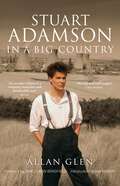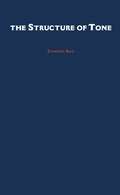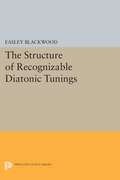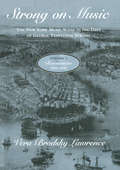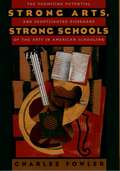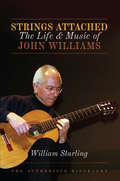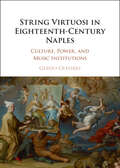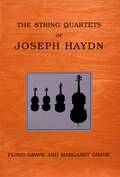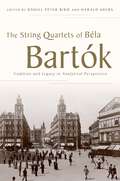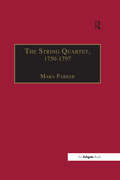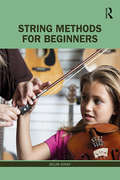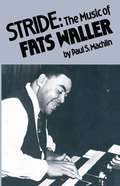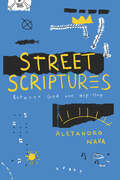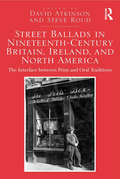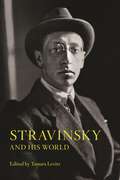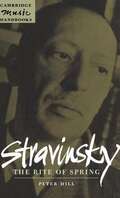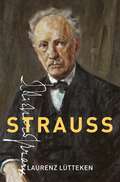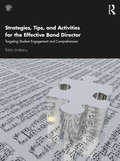- Table View
- List View
Stuart Adamson: In a Big Country
by Allan GlenThis is the book that fans of the Skids, Big Country and the Raphaels have been waiting for - a critical perspective not only of Adamson's music and its wider cultural influence, but also the excesses of fame and how the music business really works. Stuart Adamson: In a Big Country tells the story of how a teenager who was raised in a small Fife village released his first single at 19, wrote three Top 40 albums in the next three years and was written off as a has-been at 23, but then went on to form a new band and sell more than 10 million records worldwide, touring with the Rolling Stones and David Bowie. Although Stuart Adamson was one of the most respected and popular figures in the music industry, his personal life was complex - depression, alcoholism and estrangement - and ultimately tragic, ending with his suicide in a Hawaiian hotel in December 2001.
The Structure Of Tone
by Zhiming BaoThis book argues a fresh theory about the structure of tone. Bao investigates a wide range of tone sandhi data from various Chinese dialects and other Asian tone languages, providing empirical support for his proposal that tone is a formal entity which consists of register and contour. Bao establishes a clear typological distinction between register tone languages and contour tone languages whose contour tones have a more complex structure.
The Structure of Recognizable Diatonic Tunings
by Easley BlackwoodIn a comprehensive work with important implications for tuning theory and musicology, Easley Blackwood, a distinguished-composer, establishes a mathematical basis for the family of diatonic tunings generated by combinations of perfect fifths and octaves.Originally published in 1986.The Princeton Legacy Library uses the latest print-on-demand technology to again make available previously out-of-print books from the distinguished backlist of Princeton University Press. These editions preserve the original texts of these important books while presenting them in durable paperback and hardcover editions. The goal of the Princeton Legacy Library is to vastly increase access to the rich scholarly heritage found in the thousands of books published by Princeton University Press since its founding in 1905.
Strong on Music: The New York Music Scene in the Days of George Templeton Strong, Volume 1: Resonances, 1836-1849
by Vera Brodsky LawrenceIn Strong on Music Vera Brodsky Lawrence uses the diaries of lawyer and music lover George Templeton Strong as a jumping-off point from which to explore every aspect of New York City's musical life in the mid-nineteenth century. Formerly a concert pianist, Vera Brodsky Lawrence spent the last third of her life as a historian of American music (she died in 1996). She was editor of The Piano Works of Louis Moreau Gottschalk and The Complete Works of Scott Joplin. On Volume 1: "A marvelous book. There is nothing like it in the literature of American music."—Harold C. Schonberg, New York Times Book Review On Volume 2: "A monumental achievement."—Victor Fell Yellin, Opera Quarterly
Strong Arts, Strong Schools: The Promising Potential and Shortsighted Disregard of the Arts in American Schooling
by the late Charles FowlerIn this elegantly written, passionately argued book, Fowler presents a convincing case for teaching the arts to all children. He argues that, far from a luxury, the arts are a vitally important part of our society and our schools. Highlighting the crucial effect of the arts on learning, this volume shows how the arts can enliven and extend the entire school curriculum by integrating different subjects in innovative interdisciplinary ways. These eighteen compelling essays are a clarion call to action for any teacher, parent, policy maker, or citizen concerned about the fate of the arts in American society and schools.
Strong Arts, Strong Schools: The Promising Potential and Shortsighted Disregard of the Arts in American Schooling
by the late Charles FowlerIn this elegantly written, passionately argued book, Fowler presents a convincing case for teaching the arts to all children. He argues that, far from a luxury, the arts are a vitally important part of our society and our schools. Highlighting the crucial effect of the arts on learning, this volume shows how the arts can enliven and extend the entire school curriculum by integrating different subjects in innovative interdisciplinary ways. These eighteen compelling essays are a clarion call to action for any teacher, parent, policy maker, or citizen concerned about the fate of the arts in American society and schools.
Strings Attached: The Life and Music of John Williams
by William StarlingStrings Attached is the much anticipated authorised biography of John Williams, one of the most accomplished and celebrated musicians of his generation. From his childhood in Australia to his stellar career in London and around the world, John Williams has lived an extraordinary life. Master of the classical repertoire, he took the guitar to a wider audience with the band SKY and by his championing of the music of South America and Africa. William Starling came to know John Williams through their mutual friend, jazz guitarist John Etheridge. As their friendship developed, he put it to the maestro that it was time for a biography. To his lasting amazement, the famously private Williams agreed. Strings Attached is the product of extensive research and uniquely privileged access to John Williams, his family, friends and musical associates. It is the first telling of the fascinating life and career of a world-renowned musician and, equally, the story of a man and the making of his identity.
String Virtuosi in Eighteenth-Century Naples: Culture, Power, And Music Institutions
by Guido OlivieriThe String Quartets of Joseph Haydn
by Floyd Grave Margaret GraveRenowned music historians Floyd and Margaret Grave present a fresh perspective on a comprehensive survey of the works. This thorough and unique analysis offers new insights into the creation of the quartets, the wealth of musical customs and conventions on which they draw, the scope of their innovations, and their significance as reflections of Haydn's artistic personality. Each set of quartets is characterized in terms of its particular mix of structural conventions and novelties, stylistic allusions, and its special points of connection with other opus groups in the series. Throughout the book, the authors draw attention to the boundless supply of compositional strategies by which Haydn appears to be continually rethinking, reevaluating, and refining the quartet's potentials. They also lucidly describe Haydn's famous penchant for wit, humor, and compositional artifice, illuminating the unexpected connections he draws between seemingly unrelated ideas, his irony, and his lightning bolts of surprise and thwarted expectation. Approaching the quartets from a variety of vantage points, the authors correct many prevailing assumptions about convention, innovation, and developing compositional technique in the music of Haydn and his contemporaries.
The String Quartets of Joseph Haydn
by Floyd Grave Margaret GraveRenowned music historians Floyd and Margaret Grave present a fresh perspective on a comprehensive survey of the works. This thorough and unique analysis offers new insights into the creation of the quartets, the wealth of musical customs and conventions on which they draw, the scope of their innovations, and their significance as reflections of Haydn's artistic personality. Each set of quartets is characterized in terms of its particular mix of structural conventions and novelties, stylistic allusions, and its special points of connection with other opus groups in the series. Throughout the book, the authors draw attention to the boundless supply of compositional strategies by which Haydn appears to be continually rethinking, reevaluating, and refining the quartet's potentials. They also lucidly describe Haydn's famous penchant for wit, humor, and compositional artifice, illuminating the unexpected connections he draws between seemingly unrelated ideas, his irony, and his lightning bolts of surprise and thwarted expectation. Approaching the quartets from a variety of vantage points, the authors correct many prevailing assumptions about convention, innovation, and developing compositional technique in the music of Haydn and his contemporaries.
The String Quartets of Béla Bartók: Tradition and Legacy in Analytical Perspective
Béla Bartók (1881-1945) was one of the most important composers and musical thinkers of the 20th century. His contributions as a composer, as a performer and as the father of ethnomusicology changed the course of music history and of our contemporary perception of music itself. At the center of Bartók's oeuvre are his string quartets, which are generally acknowledged as some of the most significant pieces of 20th century chamber music. The String Quartets of Béla Bartók brings together innovative new scholarship from 14 internationally recognized music theorists, musicologists, performers, and composers to focus on these remarkable works from a range of theoretical and methodological perspectives. Focusing on a variety of aspects of the string quartets-harmony and tonality, form, rhythm and meter, performance and listening-it considers both the imprint of folk and classical traditions on Bartók's string quartets, and the ways in which they influenced works of the next generation of Hungarian composers. Rich with notated music examples the volume is complemented by an Oxford Web Music companion website offering additional notated as well as recorded examples. The String Quartets of Béla Bartók, reflecting the impact of the composer himself, is an essential resource for scholars and students across a variety of fields from music theory and musicology, to performance practice and ethnomusicology.
The String Quartet, 1750–1797: Four Types of Musical Conversation
by Mara ParkerThe second half of the eighteenth century witnessed a flourishing of the string quartet, often represented as a smooth and logical progression from first violin-dominated homophony to a more equal conversation between the four voices. Yet this progression was neither as smooth nor as linear as previously thought, as Mara Parker illustrates in her examination of the string quartet during this period. Looking at a wide variety of string quartets by composers such as Pleyel, Distler and Filtz, in addition to Haydn and Mozart, the book proposes a new way of describing the relationships between the four instruments in different works. Broadly speaking, these relationships follow one of four patterns: the 'lecture', the 'polite conversation', the 'debate', and the 'conversation'. In focusing on these musical discourses, it becomes apparent that each work is the product of its composer's stylistic choices, location, intended performers and intended audience. Instead of evolving in a strict and universal sequence, the string quartet in the latter half of the eighteenth century was a complex genre with composers mixing and matching musical discourses as circumstances and their own creative impulses required.
The String Quartet, 1750–1797: Four Types of Musical Conversation
by Mara ParkerThe second half of the eighteenth century witnessed a flourishing of the string quartet, often represented as a smooth and logical progression from first violin-dominated homophony to a more equal conversation between the four voices. Yet this progression was neither as smooth nor as linear as previously thought, as Mara Parker illustrates in her examination of the string quartet during this period. Looking at a wide variety of string quartets by composers such as Pleyel, Distler and Filtz, in addition to Haydn and Mozart, the book proposes a new way of describing the relationships between the four instruments in different works. Broadly speaking, these relationships follow one of four patterns: the 'lecture', the 'polite conversation', the 'debate', and the 'conversation'. In focusing on these musical discourses, it becomes apparent that each work is the product of its composer's stylistic choices, location, intended performers and intended audience. Instead of evolving in a strict and universal sequence, the string quartet in the latter half of the eighteenth century was a complex genre with composers mixing and matching musical discourses as circumstances and their own creative impulses required.
String Methods for Beginners
by Selim GirayString Methods for Beginners is designed for students to receive the essential playing and teaching skills on all orchestral string instruments. The goal of this textbook is to be truly methodical in its approach, and to assist the instructor, completely eliminating the need to do additional research, or reorganization in preparation to teach this class. Students will gain the basic knowledge and experience to teach bowed stringed instruments in public schools. String Methods for Beginners covers the necessary topics to learn and teach the violin, viola, cello, and string bass. It explores the fundamentals of those instruments and teaching considerations, utilizing a heterogeneous approach. As the primary resource to any college- and university-level String Techniques, String Methods, or Instrumental Methods class, this course book fits into a standard semester, comprised of 25 lessons, which correspond with two hourly classes per week for the term. It provides the instructor with the tools to teach a classroom of non-majors or string education majors, or a mixed classroom of both. FEATURES Offers a blueprint for a semester long string methods course. For beginning students, and also comprehensive for more in-depth study or for reference. Logical, step-by-step "recipe-like" approach.
String Methods for Beginners
by Selim GirayString Methods for Beginners is designed for students to receive the essential playing and teaching skills on all orchestral string instruments. The goal of this textbook is to be truly methodical in its approach, and to assist the instructor, completely eliminating the need to do additional research, or reorganization in preparation to teach this class. Students will gain the basic knowledge and experience to teach bowed stringed instruments in public schools. String Methods for Beginners covers the necessary topics to learn and teach the violin, viola, cello, and string bass. It explores the fundamentals of those instruments and teaching considerations, utilizing a heterogeneous approach. As the primary resource to any college- and university-level String Techniques, String Methods, or Instrumental Methods class, this course book fits into a standard semester, comprised of 25 lessons, which correspond with two hourly classes per week for the term. It provides the instructor with the tools to teach a classroom of non-majors or string education majors, or a mixed classroom of both. FEATURES Offers a blueprint for a semester long string methods course. For beginning students, and also comprehensive for more in-depth study or for reference. Logical, step-by-step "recipe-like" approach.
Stride: The Music of Fats Waller
by Paul S MachlinAlready known as a Wagner scholar for his work on the sketches of the Flying Dutchman, Paul Machlin has for many years taken a scholarly interest in the school of Harlem 'stride' jazz pianists. Stride: The Music of Fats Waller is a full analysis of the piano music of Waller as composer, soloist and recording artist. 38 music examples illustrate Waller's complex keyboard style and improvisatory techniques. The discussion of Waller's piano music is set in the context of a biographical study, and a discography listing all known recordings by the pianist.
Street Scriptures: Between God and Hip-Hop
by Alejandro NavaThis book explores an important aspect of hip-hop that is rarely considered: its deep entanglement with spiritual life. The world of hip-hop is saturated with religion, but rarely is that element given serious consideration. In Street Scriptures, Alejandro Nava focuses our attention on this aspect of the music and culture in a fresh way, combining his profound love of hip-hop, his passion for racial and social justice, and his deep theological knowledge. Street Scriptures offers a refreshingly earnest and beautifully written journey through hip-hop’s deep entanglement with the sacred. Nava reveals a largely unheard religious heartbeat in hip-hop, exploring crosscurrents of the sacred and profane in rap, reggaeton, and Latinx hip-hop today. Ranging from Kendrick Lamar, Chance the Rapper, Lauryn Hill, Cardi B, and Bad Bunny to St. Augustine and William James, Nava examines the ethical-political, mystical-prophetic, and theological qualities in hip-hop, probing the pure sonic and aesthetic signatures of music, while also diving deep into the voices that invoke the spirit of protest. The result is nothing short of a new liberation theology for our time, what Nava calls a “street theology.”
Street Ballads in Nineteenth-Century Britain, Ireland, and North America: The Interface between Print and Oral Traditions
by David Atkinson Steve RoudIn recent years, the assumption that traditional songs originated from a primarily oral tradition has been challenged by research into ’street literature’ - that is, the cheap printed broadsides and chapbooks that poured from the presses of jobbing printers from the late sixteenth century until the beginning of the twentieth. Not only are some traditional singers known to have learned songs from printed sources, but most of the songs were composed by professional writers and reached the populace in printed form. Street Ballads in Nineteenth-Century Britain, Ireland, and North America engages with the long-running debate over the origin of traditional songs by examining street literature’s interaction with, and influence on, oral traditions.
Street Ballads in Nineteenth-Century Britain, Ireland, and North America: The Interface between Print and Oral Traditions
by David Atkinson Steve RoudIn recent years, the assumption that traditional songs originated from a primarily oral tradition has been challenged by research into ’street literature’ - that is, the cheap printed broadsides and chapbooks that poured from the presses of jobbing printers from the late sixteenth century until the beginning of the twentieth. Not only are some traditional singers known to have learned songs from printed sources, but most of the songs were composed by professional writers and reached the populace in printed form. Street Ballads in Nineteenth-Century Britain, Ireland, and North America engages with the long-running debate over the origin of traditional songs by examining street literature’s interaction with, and influence on, oral traditions.
Stravinsky and His World
by Tamara LevitzStravinsky and His World brings together an international roster of scholars to explore fresh perspectives on the life and music of Igor Stravinsky. Situating Stravinsky in new intellectual and musical contexts, the essays in this volume shed valuable light on one of the most important composers of the twentieth century. Contributors examine Stravinsky's interaction with Spanish and Latin American modernism, rethink the stylistic label "neoclassicism" with a section on the ideological conflict over his lesser-known opera buffa Mavra, and reassess his connections to his homeland, paying special attention to Stravinsky's visit to the Soviet Union in 1962. The essays also explore Stravinsky's musical and religious differences with Arthur Lourié, delve into Stravinsky's collaboration with Pyotr Suvchinsky and Roland-Manuel in the genesis of his groundbreaking Poetics of Music, and look at how the movement within stasis evident in the scores of Stravinsky's Orpheus and Oedipus Rex reflected the composer's fierce belief in fate. Rare documents--including Spanish and Mexican interviews, Russian letters, articles by Arthur Lourié, and rarely seen French and Russian texts--supplement the volume, bringing to life Stravinsky's rich intellectual milieu and intense personal relationships. The contributors are Tatiana Baranova, Leon Botstein, Jonathan Cross, Valérie Dufour, Gretchen Horlacher, Tamara Levitz, Klára Móricz, Leonora Saavedra, and Svetlana Savenko.
Stravinsky and His World
by Tamara LevitzStravinsky and His World brings together an international roster of scholars to explore fresh perspectives on the life and music of Igor Stravinsky. Situating Stravinsky in new intellectual and musical contexts, the essays in this volume shed valuable light on one of the most important composers of the twentieth century. Contributors examine Stravinsky's interaction with Spanish and Latin American modernism, rethink the stylistic label "neoclassicism" with a section on the ideological conflict over his lesser-known opera buffa Mavra, and reassess his connections to his homeland, paying special attention to Stravinsky's visit to the Soviet Union in 1962. The essays also explore Stravinsky's musical and religious differences with Arthur Lourié, delve into Stravinsky's collaboration with Pyotr Suvchinsky and Roland-Manuel in the genesis of his groundbreaking Poetics of Music, and look at how the movement within stasis evident in the scores of Stravinsky's Orpheus and Oedipus Rex reflected the composer's fierce belief in fate. Rare documents--including Spanish and Mexican interviews, Russian letters, articles by Arthur Lourié, and rarely seen French and Russian texts--supplement the volume, bringing to life Stravinsky's rich intellectual milieu and intense personal relationships. The contributors are Tatiana Baranova, Leon Botstein, Jonathan Cross, Valérie Dufour, Gretchen Horlacher, Tamara Levitz, Klára Móricz, Leonora Saavedra, and Svetlana Savenko.
Strauss (Master Musicians Series)
by Laurenz LüttekenRichard Strauss is an outlier in the context of twentieth century music. Some consider him a composer of the late romantic period, while others declare him a traitor of modernity for his role in National Socialism. Despite the controversy surrounding him, Strauss's works--even beyond his most well-known operas Elektra and Rosenkavalier--are present in the repertories of concert halls worldwide and continue to enjoy large audiences. The details of the composer's life, however, remain shrouded in mystery and gossip. Laurenz Lütteken's Strauss presents a fresh approach to understanding this elusive composer's life and works. Dispensing with stereotypes and sensationalism, it reveals Strauss to be a sensitive intellectual and representative of modernity, with all light and shade of the turn of the twentieth century.
Strauss (Master Musicians Series)
by Laurenz LüttekenRichard Strauss is an outlier in the context of twentieth century music. Some consider him a composer of the late romantic period, while others declare him a traitor of modernity for his role in National Socialism. Despite the controversy surrounding him, Strauss's works--even beyond his most well-known operas Elektra and Rosenkavalier--are present in the repertories of concert halls worldwide and continue to enjoy large audiences. The details of the composer's life, however, remain shrouded in mystery and gossip. Laurenz Lütteken's Strauss presents a fresh approach to understanding this elusive composer's life and works. Dispensing with stereotypes and sensationalism, it reveals Strauss to be a sensitive intellectual and representative of modernity, with all light and shade of the turn of the twentieth century.
Strategies, Tips, and Activities for the Effective Band Director: Targeting Student Engagement and Comprehension
by Robin LinaberryStrategies, Tips, and Activities for the Effective Band Director: Targeting Student Engagement and Comprehension is a resourceful collection of highly effective teaching strategies, solutions, and activities for band directors. Chapters are aligned to cover common topics, presenting several practical lesson ideas for each topic. In most cases, each pedagogical suggestion is supported by excerpts from standard concert band literature. Topics covered include: score study shortcuts; curriculum development; percussion section management; group and individual intonation; effective rehearsal strategies; and much more! This collection of specific concepts, ideas, and reproducible pedagogical methods—not unlike short lesson plans—can be used easily and immediately. Ideal for band directors of students at all levels, Strategies, Tips, and Activities for the Effective Band Director is the product of more than three decades of experience, presenting innovative approaches, as well as strategies that have been borrowed, revised, and adapted from scores of successful teachers and clinicians.
